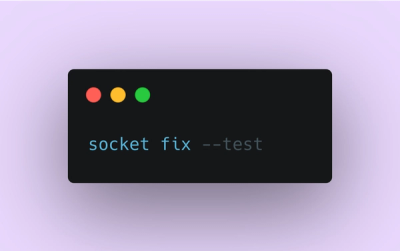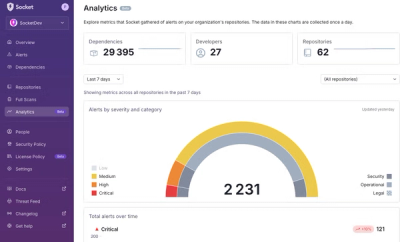
Product
Introducing Socket Fix for Safe, Automated Dependency Upgrades
Automatically fix and test dependency updates with socket fix—a new CLI tool that turns CVE alerts into safe, automated upgrades.
@amirrezasalimi/react-use-oauth2
Advanced tools
A React hook that handles OAuth2 authorization flow.
💎 A custom React hook that makes OAuth2 authorization simple. Both for Implicit Grant and Authorization Code flows.
Implicit and Authorization Code grant flows.Requires react@18.0.0 or higher
yarn add @tasoskakour/react-use-oauth2
or
npm i @tasoskakour/react-use-oauth2
For authorization code flow:
import { OAuth2Popup, useOAuth2 } from "@tasoskakour/react-use-oauth2";
import { BrowserRouter, Routes, Route } from "react-router-dom";
const Home = () => {
const { data, loading, error, getAuth, logout } = useOAuth2({
authorizeUrl: "https://example.com/auth",
clientId: "YOUR_CLIENT_ID",
redirectUri: `${document.location.origin}/callback`,
scope: "YOUR_SCOPES",
responseType: "code",
exchangeCodeForTokenQuery: {
url: "https://your-backend/token",
method: "POST",
},
onSuccess: (payload) => console.log("Success", payload),
onError: (error_) => console.log("Error", error_)
});
const isLoggedIn = Boolean(data?.access_token); // or whatever...
if (error) {
return <div>Error</div>;
}
if (loading) {
return <div>Loading...</div>;
}
if (isLoggedIn) {
return (
<div>
<pre>{JSON.stringify(data)}</pre>
<button onClick={logout}>Logout</button>
</div>
)
}
return (
<button style={{ margin: "24px" }} type="button" onClick={() => getAuth()}>
Login
</button>
);
};
const App = () => {
return (
<BrowserRouter>
<Routes>
<Route element={<OAuthPopup />} path="/callback" />
<Route element={<Home />} path="/" />
</Routes>
</BrowserRouter>
);
};
exchangeCodeForTokenQueryFnYou can also use exchangeCodeForTokenQueryFn if you want full control over your query to your backend, e.g if you must send your data as form-urlencoded:
const { ... } = useOAuth2({
// ...
// Instead of exchangeCodeForTokenQuery (e.g sending form-urlencoded or similar)...
exchangeCodeForTokenQueryFn: async (callbackParameters) => {
const formBody = [];
for (const key in callbackParameters) {
formBody.push(
`${encodeURIComponent(key)}=${encodeURIComponent(callbackParameters[key])}`
);
}
const response = await fetch(`YOUR_BACKEND_URL`, {
method: 'POST',
body: formBody.join('&'),
headers: {
'Content-Type': 'application/x-www-form-urlencoded;charset=UTF-8',
},
});
if (!response.ok) throw new Error('Failed');
const tokenData = await response.json();
return tokenData;
},.
// ...
})
exchangeCodeForTokenQuery for Authorization Code flows?Generally when we're working with authorization code flows, we need to immediately exchange the retrieved code with an actual access token, after a successful authorization. Most of the times this is needed for back-end apps, but there are many use cases this is useful for front-end apps as well.
In order for the flow to be accomplished, the 3rd party provider we're authorizing against (e.g Google, Facebook etc), will provide an API call (e.g for Google is https://oauth2.googleapis.com/token) that we need to hit in order to exchange the code for an access token. However, this call requires the client_secret of your 3rd party app as a parameter to work - a secret that you cannot expose to your front-end app.
That's why you need to proxy this call to your back-end and with exchangeCodeForTokenQuery object you can provide the schematics of your call e.g url, method etc. The request parameters that will get passed along as query parameters are { code, client_id, grant_type, redirect_uri, state }. By default this will be a POST request but you can change it with the method property.
You can read more about "Exchanging authorization code for refresh and access tokens" in Google OAuth2 documentation.
exchangeCodeForTokenQueryFn?There could be certain cases where exchangeCodeForTokenQuery is not enough and you want full control over how you send the request to your backend. For example you may want to send it as a urlencoded form. With this property you can define your callback function which takes callbackParameters: object as a parameter (which includes whatever returned from OAuth2 callback e.g code, scope, state etc) and must return a promise with a valid object which will contain all the token data state e.g access_token, expires_in etc.
With an implicit grant flow things are much simpler as the 3rd-party provider immediately returns the access_token to the callback request so there's no need to make any action after that. Just set responseType=token to use this flow.
After a successful authorization, data will get persisted to localStorage and the state will automatically sync to all tabs/pages of the browser. The storage key the data will be written to will be: {responseType}-{authorizeUrl}-{clientId}-{scope}.
If you want to re-trigger the authorization flow just call getAuth() function again.
Note: In case localStorage is throwing an error (e.g user has disabled it) then you can use the isPersistent property which - for this case - will be false. Useful if you want to notify the user that the data is only stored in-memory.
function useOAuth2(options): {data, loading, error, getAuth}This is the hook that makes this package to work. Options is an object that contains the properties below
authorizeUrl (string): The 3rd party authorization URL (e.g https://accounts.google.com/o/oauth2/v2/auth).clientId (string): The OAuth2 client id of your application.redirectUri (string): Determines where the 3rd party API server redirects the user after the user completes the authorization flow. In our example the Popup is rendered on that redirectUri.scope (string - optional): A list of scopes depending on your application needs.responseType (string): Can be either code for code authorization grant or token for implicit grant.extraQueryParameters (object - optional): An object of extra parameters that you'd like to pass to the query part of the authorizeUrl, e.g {audience: "xyz"}.exchangeCodeForTokenQuery (object): This property is only required when using code authorization grant flow (responseType = code). It's properties are:
url (string - required) It specifies the API URL of your server that will get called immediately after the user completes the authorization flow. Read more here.method (string - required): Specifies the HTTP method that will be used for the code-for-token exchange to your server. Defaults to POSTheaders (object - optional): An object of extra parameters that will be used for the code-for-token exchange to your server.exchangeCodeForTokenQueryFn function(callbackParameters) => Promise<Object>: Instead of using exchangeCodeForTokenQuery to describe the query, you can take full control and provide query function yourself. callbackParameters will contain everything returned from the OAUth2 callback e.g code, state etc. You must return a promise with a valid object that will represent your final state - data of the auth procedure.Returns:
data (object): Consists of the retrieved auth data and generally will have the shape of {access_token, token_type, expires_in} (check Typescript usage for providing custom shape). If you're using responseType: code and exchangeCodeForTokenQueryFn this object will contain whatever you returnn from your query function.loading (boolean): Is set to true while the authorization is taking place.error (string): Is set when an error occurs.getAuth (function): Call this function to trigger the authorization flow.logout (function): Call this function to logout and clear all authorization data.isPersistent (boolean): Property that returns false if localStorage is throwing an error and the data is stored only in-memory. Useful if you want to notify the user.function OAuthPopup(props)This is the component that will be rendered as a window Popup for as long as the authorization is taking place. You need to render this in a place where it does not disrupt the user flow. An ideal place is inside a Route component of react-router-dom as seen in the usage example.
Props consists of:
Component (ReactElement - optional): You can optionally set a custom component to be rendered inside the Popup. By default it just displays a "Loading..." message.The useOAuth2 function identity is:
const useOAuth2: <TData = AuthTokenPayload>(props: Oauth2Props<TData>) => {
data: State<AuthTokenPayload>;
loading: boolean;
error: null;
getAuth: () => () => void;
}
That means that generally the data will have the shape of AuthTokenPayload which consists of:
token_type: string;
expires_in: number;
access_token: string;
scope: string;
refresh_token: string;
And that also means that you can set the data type by using the hook like this:
type MyCustomShapeData = {
...
}
const {data, ...} = useOAuth2<MyCustomShapeData>({...});
Please follow the steps below to migrate to v2.0.0:
exchangeCodeForTokenServerURL, exchangeCodeForTokenMethod, exchangeCodeForTokenHeadersexchangeCodeForTokenQuery
exchangeCodeForTokenQuery just combines all the above deprecated properties, e.g you can use it like: exchangeCodeForTokenQuery: { url:"...", method:"POST", headers:{} }You can run tests by calling
npm test
It will start a react-app (:3000) and back-end server (:3001) and then it will run the tests with jest & puppeteer.
FAQs
A React hook that handles OAuth2 authorization flow.
The npm package @amirrezasalimi/react-use-oauth2 receives a total of 10 weekly downloads. As such, @amirrezasalimi/react-use-oauth2 popularity was classified as not popular.
We found that @amirrezasalimi/react-use-oauth2 demonstrated a healthy version release cadence and project activity because the last version was released less than a year ago. It has 1 open source maintainer collaborating on the project.
Did you know?

Socket for GitHub automatically highlights issues in each pull request and monitors the health of all your open source dependencies. Discover the contents of your packages and block harmful activity before you install or update your dependencies.

Product
Automatically fix and test dependency updates with socket fix—a new CLI tool that turns CVE alerts into safe, automated upgrades.

Security News
CISA denies CVE funding issues amid backlash over a new CVE foundation formed by board members, raising concerns about transparency and program governance.

Product
We’re excited to announce a powerful new capability in Socket: historical data and enhanced analytics.